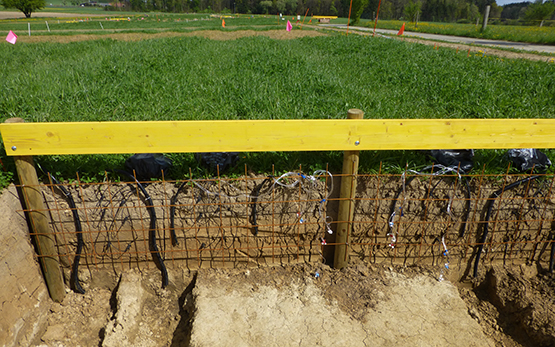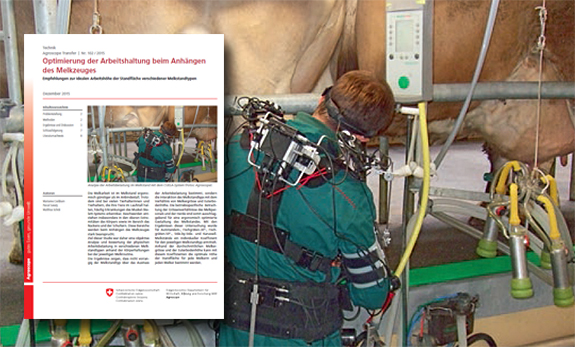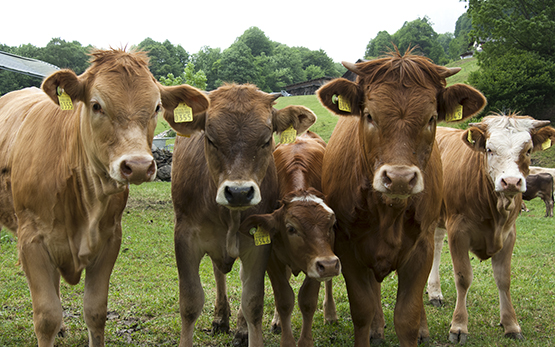Keller M., Reidy B., Scheurer A., Eggerschwiler L., Morel I., Giller K.
Soybean meal can be replaced by faba bean, pumpkin seed cake, spirulina or be completely omitted in a forage-based diet for fattening bulls to achieve comparable performance, carcass and meat quality.
Animals, 11, (6), 2021, 1-18.
Pontiggia A., Münger A., Eggerschwiler L., Stucki D., Ammer S., Bruckmaier R., Dohme-Meier F., Keil N.
Early detection of heat stress in grazing dairy cows by use of behavioural and physiological traits.
In: Book of Abstracts of the 72nd Annual Meeting of the European Federation of Animal Science. 30.08., Hrsg. EAAP scientific committee, Davos. 2021, 134.
Lazzari G., Münger A., Eggerschwiler L., Zähner M., Schrade S., Dohme-Meier F.
Silage type and Acacia mearnsii supplementation influence nitrogen metabolism of dairy cows and ammonia released from their excreta.
Meyer-Binzegger M., Ollagnier C., Eggerschwiler L., Bühler K., Meylan M., Schlegel P.
Rumen bolus containing 1,25(OH)2D3-glycosides for the prevention of hypocalcemia in dairy cows.
In: 72nd Annual Meeting of the European Federation of Animal Science. 2 September, Hrsg. EAAP, Davos. 2021, 1-2.
Meyer-Binzegger M., Ollagnier C., Eggerschwiler L., Bühler K., Meylan M., Schlegel P.
Rumen bolus containing 1,25(OH)2D3-glycosides for the prevention of hypocalcemia in dairy cows.
In: 72nd Annual Meeting of the European Federation of Animal Science. 2 September, Hrsg. EAAP, Davos. 2021, 1-12.
Lazzari G., Münger A., Eggerschwiler L., Zähner M., Kreuzer M., Schrade S., Dohme-Meier F.
Silage type and Acacia mearnsii supplementation influence nitrogen metabolism of dairy cows and ammonia released from their excreta.
In: EAAP 2021. 01.09., Davos - EAAP. 2021.
Lazzari G., Münger A., Eggerschwiler L., Zähner M., Kreuzer M., Schrade S., Dohme-Meier F.
Effect of acacia mearnsii supplementation in forage-based diets on dairy cows ruminal methane emissions measured by the greenfeed.
In: Proceedings of EurAgEng 2021 "New Challenges for Agricultural Engineering towards a Digital World". July, Hrsg. University of Evora, Evora. 2021, 180.
Münger A., Eggerschwiler L., Reiche A.-M., Dohme-Meier F.
Comparison of tanniferous wood extracts in their effect on methane production of dairy cows.
Proceedings of the Society of Nutrition Physiology, 30, 2021, 126.
Lazzari G., Münger A., Eggerschwiler L., Zähner M., Kreuzer M., Schrade S., Dohme-Meier F.
Effect of Acacia mearnsii supplementation on ruminal fermentation characteristics and methane production of dairy cows fed diets differing in silage type.
In: 75 digital Conference of the Society of Nutrition. Vol. 30, Hrsg. Proceedings of the Society of Nutrition Physiology, DLG-Verlag, Frankfurt am Main. 2021, 125.
Pontiggia A., Münger A., Dohme-Meier F., Eggerschwiler L., Stucki D., Heuwieser W., Ammer S., Bruckmaier R., Keil N.
Body temperature of grazing Holstein dairy cows reacts to increasing climate indices.
In: Proceedings of the Agroscope PhD - Postdoc Symposium 2021. April, Hrsg. Agroscope, Agroscope. 2021, 61.
Pontiggia A., Münger A., Eggerschwiler L., Stucke D., Ammer S., Schüller L., Heuwieser W., Bruckmeier R., Dohme-Meier F., Keil N.
Verhaltensmerkmale zur Erkennung von beginnendem Hitzestress bei weidenden Milchkühen.
KTBL-Schrift, 520, 2020, 79-88.
Pontiggia A., Münger A., Eggerschwiler L., Stucki D., Ammer S., Schüller L, Heuwieser W., Bruckmaier R. , Dohme-Meier F., Keil N.
Verhaltensmerkmale zur Erkennung von beginnendem Hitzestress bei weidenden Milchkühen.
In: Internationale Tagung Angewandte Ethologie. 26.-27.11., Hrsg. Deutsche Veterinärmedizinische Gesellschaft DVG, Online. 2020, 1-19.
Kiani A., Wolf C., Giller K., Eggerschwiler L., Kreuzer M., Schwarm A.
In vitro ruminal fermentation and methane inhibitory effect of three species of microalgae.
Canadian Journal of Animal Science, 100, (3), 2020, 1-9.
Lazzari G., Münger A., Eggerschwiler L., Zähner M., Kreuzer M., Schrade S., Dohme-Meier F.
Nitrogen Balance of dairy cows fed different silage-based diets with and without Acacia mearnsii tannins.
In: Proceedings of the Society of Nutrition Physiology. Band 29, Hrsg. Gesellschaft für Ernährungsphysiologie, L&W Druck, Bad Endbach D. 2020, 55.
Denninger T.M., Schwarm A., Birkinshaw A., Terranova M., Dohme-Meier F., Münger A., Eggerschwiler L., Bapst B., Wegmann S., Clauss M., Kreuzer M.
Immediate effect of Acacia mearnsii tannins on methane emissions and milk fatty acid profiles of dairy cows.
Animal Feed Science and Technology, 261, (Article number 114388), 2020, 1-13.
Denniger T. M., Dohme-Meier F., Eggerschwiler L., Vanlierde A., Grandl F., Gredler B., Kreuzer M., Schwarm A., Münger A.
Persistence of differences between dairy cows categorized as low or high methane emitters, as estimated from milk mid-infrared spectra and measured by GreenFeed.
Journal of Dairy Science, 102, (12), 2019, 11751-11765.
Terranova M. , Eggerschwiler L., Braun U., Kreuzer M., Schwarm A.
Dose-response effects of forages from woody and herbaceous plants on in vitro ruminal methane and ammonia fermentation, and their short-term palatability in lactating dairy cows.
Animal, 14, (3), 2019, 538-548.
Denninger T., Dohme-Meier F., Eggerschwiler L., Grandl F., Gredler B., Kreuzer M., Schwarm A., Münger A.
Comparison of feed intake, feeding behavior and ruminal fermentation characteristics of grazing cows categorized as low and high methane emitters.
Advances in Animal Biosciences, 10, (3), 2019, 562.
Meyer M., Ollagnier C., Bühler K., Eggerschwiler L., Meylan M., Schlegel P.
Effect of 1,25-dihydroxycholecalciferol-glycosides given as a rumen bolus on 1,25-dihydroxycholecalciferol and calcium blood pharmacokinetics in pregnant dry dairy cows.
In: The 22nd Vitamin D Workshop. May 29 - June 1, Hrsg. James Fleet, New York City. 2019, 60-60.
Meyer M., Ollagnier C., Bühler K., Eggerschwiler L., Meylan M., Schlegel P.
Effect of 1,25-dihydroxycholecalciferol-glycosides given as a rumen bolus on blood pharmacokinetics.
In: 70th Annual Meeting. 29 August, Hrsg. European Federation of Animal Science (EAAP), Ghent. 2019, 539.









